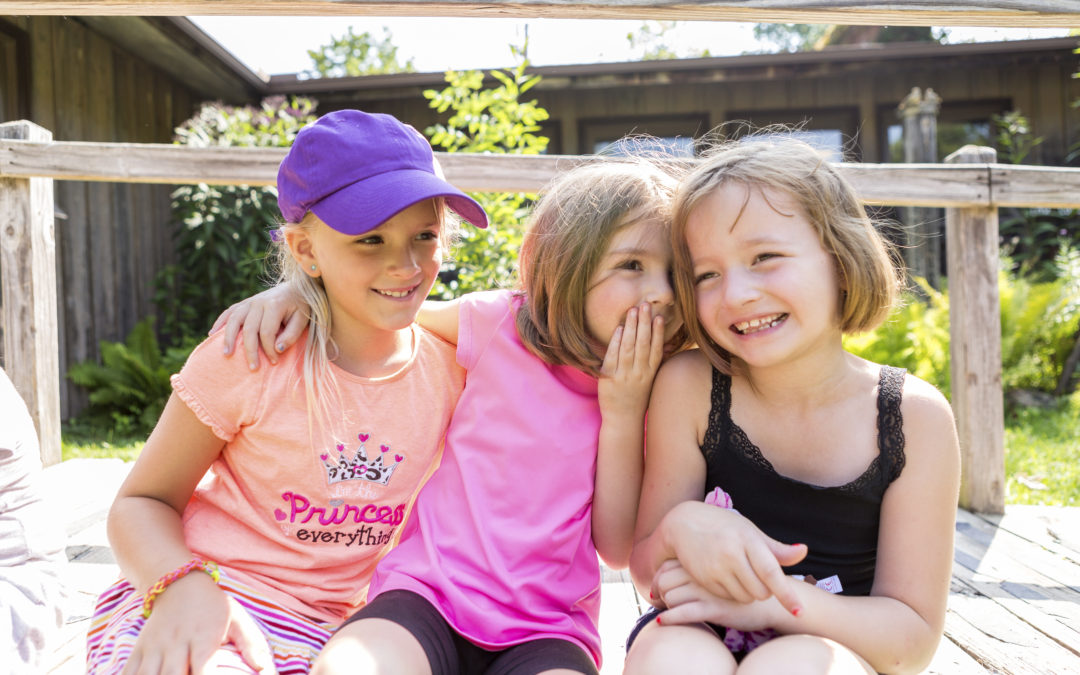As a Girl Scout volunteer, you’ll have the opportunity to guide girls of all backgrounds, heritage, behaviors, beliefs, skills, and abilities. Respecting differences and creating experiences that are welcoming to each and every girl is an important part of Girl Scouts. Volunteers like you play the largest and most important role in ensuring that all girls feel safe, welcome, and valued in Girl Scouts.
Pin this post for later!
A safe space can mean anything from a place free of hazards, to an emotionally safe place where girls feel comfortable being themselves and expressing their feelings, to establishing an atmosphere of acceptance and inclusion where they feel like they belong. Creating a safe place for girls is critical to the success of every girl in your troop. Here are 12 tips to ensure your troop environment is a safe space for girls:
1. Ensure your meeting site is accessible and safe.
Make sure your troop meeting location is accessible to all girls and can accommodate girls and parents with disabilities. Look for locations that are allergen-free, avoiding common allergens like pet dander, mold, etc. Your meeting space should be safe, secure, clean, properly ventilated, heated/cooled, free from hazards, and should have at least two exits that are well-marked and fully functional. Don’t forget to have a first aid kit on hand to handle basic bumps and bruises.
2. Create a welcoming environment.
Create a welcoming environment where new girls can easily adjust and fit in with the group. Assign each girl a buddy in the troop or assign small groups of girls to partner together. Switch buddies/groups often so girls get to collaborate and form friendships with all girls in the troop. Cooperative games and icebreaker activities can also help the girls in your troop “be a sister to every Girl Scout”.
3. Include all girls.
Foster an environment of belonging. Make sure all girls are offered the same opportunities. Respect and honor the differences and uniqueness in each girl. Teach respect for, understanding of, and dignity toward all girls and their families. Understand that each individual brings an individual—and important—experience to Girl Scouting, and embrace those differences.
4. Create an emotionally safe space.
Make sure your Girl Scout troop is a place where girls are as safe emotionally as they are physically. Create a space where girls can be themselves and feel comfortable sharing their ideas and opinions without fear, explanation, judgment, or ridicule. The environment you create is as important—maybe more—than the activities girls do; it’s the key to developing the sort of group that girls want to be part of.
5. Establish group rules and agree to follow.
Protect the emotional safety of girls by creating a team agreement and coaching girls to honor it. Agreements typically encourage behaviors like respecting a diversity of feelings and opinions; resolving conflicts constructively; and avoiding physical and verbal bullying, clique behavior, and discrimination. It’s a good idea to have the group establish expectations and agree on consequences at the very beginning. Post the rules at meetings as a reminder to all. Consequences must proceed a non-negotiable. Girls need to know there’s a consequence for those serious infractions as well as evidence to believe they are safe in in their troop environment.
Pro Tip: When establishing rules with your girls, relate them to the Girl Scout Promise and Law, so they truly know what it means to be a Girl Scout.
6. Recognize and support each girl.
Girls look up to their volunteers. They need to know that you consider each of them an important person. They can survive a poor meeting place or an activity that flops, but they cannot endure being ignored or rejected. Recognize acts of trying as well as instances of clear success. Emphasize and praise the positive qualities that make each girl worthy and unique. In addition to being a supportive leader, help girls find ways to show acceptance of and support for one another.
7. Build trust.
Girls need your belief in them and your support when they try new things. They must be sure you will not betray a confidence. Show girls you trust them to think for themselves and use their own judgment. Help them make the important decisions in the group and correct their own mistakes. Coach them to give and show trust toward one another and learn how trust can be built, lost, regained, and strengthened.
8. Promote fairness.
Girls are oftentimes sensitive to injustice. They forgive mistakes if they are sure you are trying to be fair. They look for fairness in the ways responsibilities are shared, in handling of disagreements and in responses to performance and accomplishment. When possible, consult girls as to what they think is fair before decisions are made. Explain your reasoning and show why you did something. Be willing to apologize if needed. Try to see that the responsibilities, as well as the chances for feeling important, are equally divided. Help girls explore and decide for themselves the fair ways of solving problems, carrying out activities, and responding to behavior and achievements.
9. Manage conflict swiftly and effectively.
Girls expect and want conflicts to be dealt with consistently and fairly, so it’s important to address grudges early on. If tension is building between girls create time and space for them to talk it out while you mediate. Conflicts and disagreements are an inevitable part of life, and when handled constructively can actually enhance communication and relationships. At the very least, Girl Scouts are expected to practice self-control and diplomacy so issues do not erupt into regrettable incidents. Shouting, verbal abuse, or physical confrontations are never warranted and cannot be tolerated in the Girl Scout environment. Don’t forget to check out our recent Trailhead article: Conflict Resolutions in a Troop Setting for more tips on managing conflict.
10. Keep the vibes good.
Girls, no matter how young, know when an adult is not happy. Joy can be contagious, but so too can misery. Remain calm at all times, because once you lose it in front of your girls, it takes a long time to rebuild that feeling of safety and trust. Step outside and take a few breaths—it’s worth it. Use every opportunity to model patience and find opportunities to smile, laugh, and be silly with the girls.
11. Inspire open communication.
Girls want someone who will listen to what they think, feel, and want to do. They like having someone they can talk to about important things, including things that might not seem important to adults.
- Listen to the girls. Respond with words and actions. Speak your mind openly when you are happy or concerned about something, and encourage girls to do this, too. Listening to girls, as opposed to telling them what to think, feel, or do (no “you shoulds”) is the first step in helping them take ownership of their program.
- Be honest. If you’re not comfortable with a topic or activity, say so. No one expects you to be an expert on every topic. Ask for alternatives or seek out volunteers with the required expertise. (Owning up to mistakes—and apologizing for them—goes a long way with girls.)
- Be open to real issues. For girls, important topics are things like relationships, peer pressure, school, money, and other serious issues. (You’ll also have plenty of time to discuss less weighty subjects.) When you don’t know, listen. Also, if you need assistance or more information, feel free to contact council staff at info@girlscoutsnorcal.org.
- Show respect. Girls often say that their best experiences were the ones where adults treated them as equal partners. Being spoken to as a young adult will help your girls grow.
12. Address the needs of older girls.
Consider the following tips when working with teenage girls: Think of yourself as a partner, and as a coach or mentor, as needed (not a “leader”). Ask girls what rules they need for safety and what group agreements they need to be a good team. Understand that girls need time to talk, unwind, and have fun together. Ask what they think and what they want to do, and encourage girls to speak their minds. Provide structure, but don’t micromanage—treat girls like partners and give everyone a voice in the group. Don’t repeat what’s said in the group to anyone outside of it (unless necessary for a girl’s safety). They want volunteers who are teen savvy and can help them with issues they face, such as bullying, peer pressure, dating, athletic and academic performance, and more. Some of these issues may be considered “sensitive” by parents, and they may have opinions or input about how, and whether, Girl Scouts should cover these topics with their daughters. You can read more about handling sensitive issues in Volunteer Essentials.
By following these 12 simple tips, you’ll create a safe space for girls in no time! How do you create a safe space for girls in your troop? Please share your thoughts and ideas with us in the comments section.
What to do next:
- Check out the Girls and Adults chapter in Volunteer Essentials for more ideas for creating a safe and supportive environment for girls.
- Watch the Creating an Inclusive, Safe Space for Girls online learning module for more tips and ideas.
- For a related read, check out The Girl Scout Difference, which highlights the importance of an all-girl, girl-led, and girl-friendly environment.
 Sheryl Jucker—Sheryl Jucker is the eLearning Director for Girl Scouts of Northern California. She is a former GSNorCal troop leader, Community Development Director and Volunteer Resources Director for the North Central area. She now enjoys living and working remotely in San Antonio, TX and managing a remote team of 3 eLearning Developers who are continuously developing training and resources for GSNorCal troop leaders and volunteers. She is passionate about Girl Scouting and about inspiring troop leaders to make a difference in a girl’s life and be the role model she’ll always remember.
Sheryl Jucker—Sheryl Jucker is the eLearning Director for Girl Scouts of Northern California. She is a former GSNorCal troop leader, Community Development Director and Volunteer Resources Director for the North Central area. She now enjoys living and working remotely in San Antonio, TX and managing a remote team of 3 eLearning Developers who are continuously developing training and resources for GSNorCal troop leaders and volunteers. She is passionate about Girl Scouting and about inspiring troop leaders to make a difference in a girl’s life and be the role model she’ll always remember.



This is such an important topic. Not every organization provides this opportunity for girls and it’s so important that we as leaders continue to uphold these values!